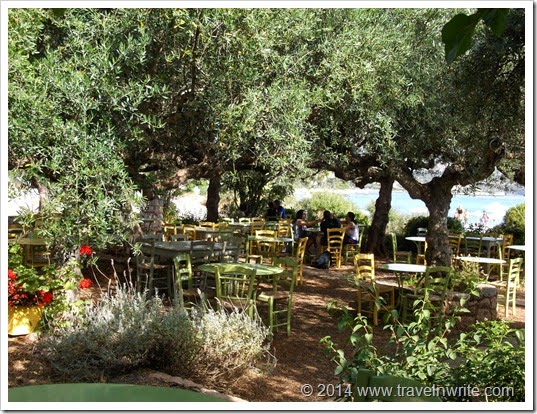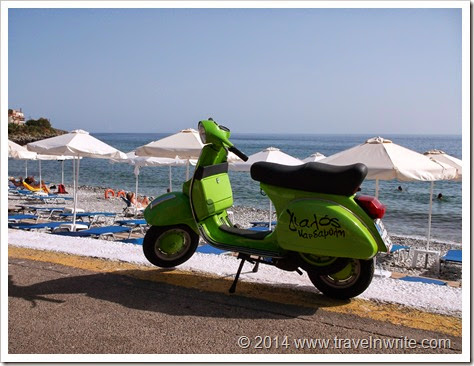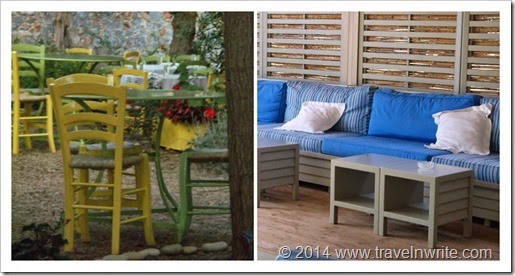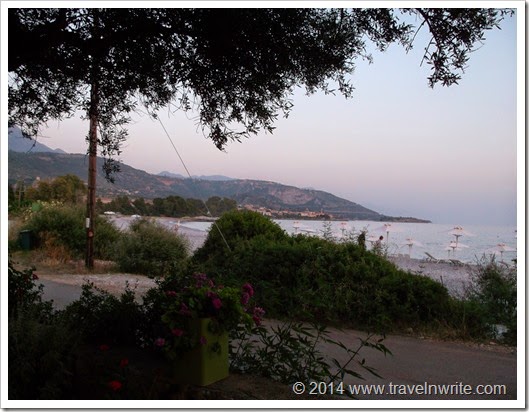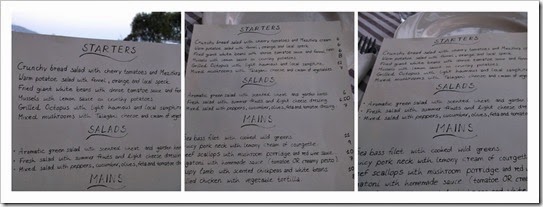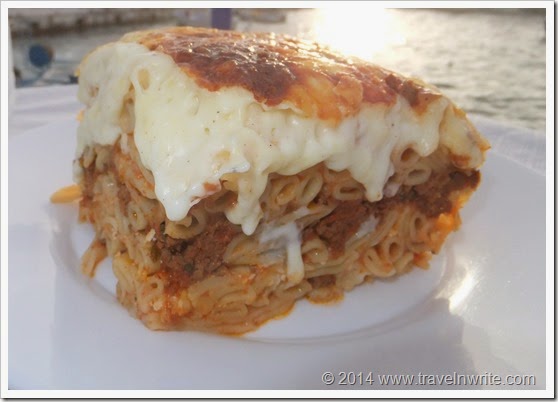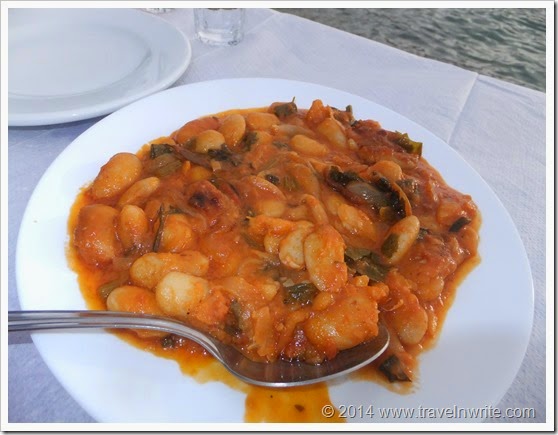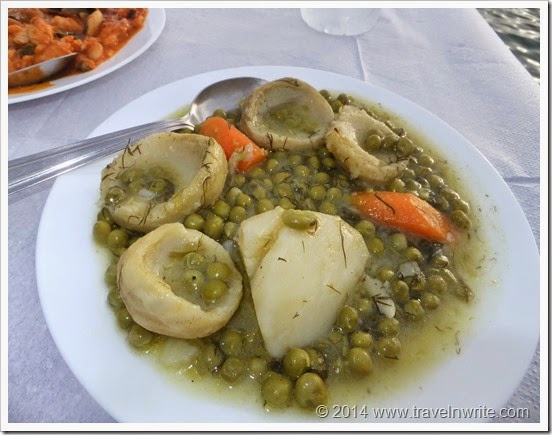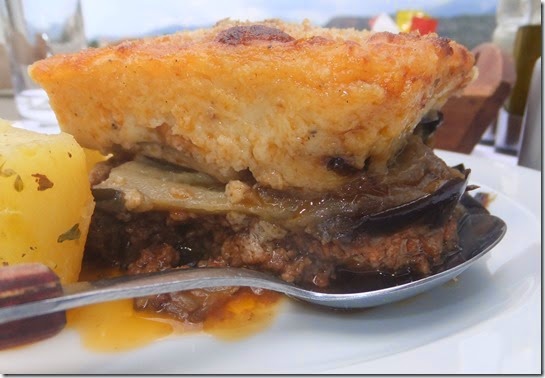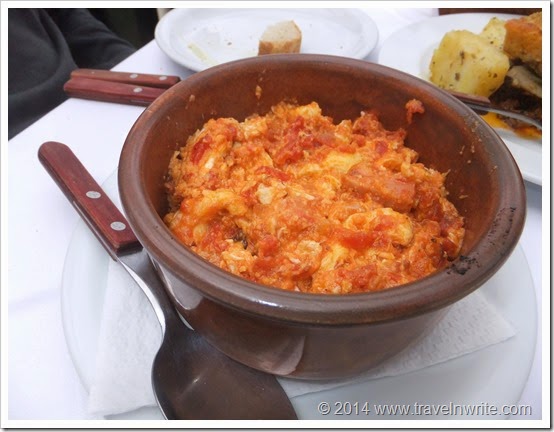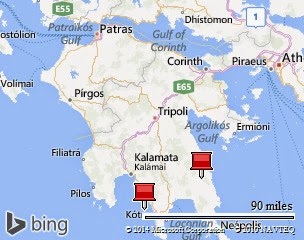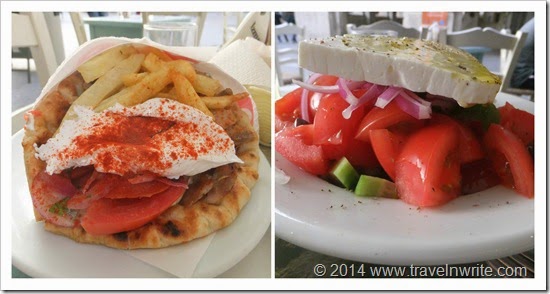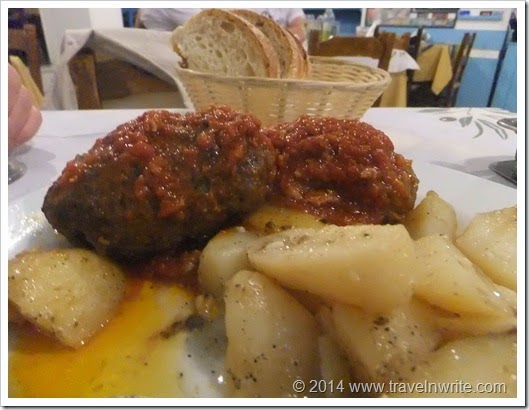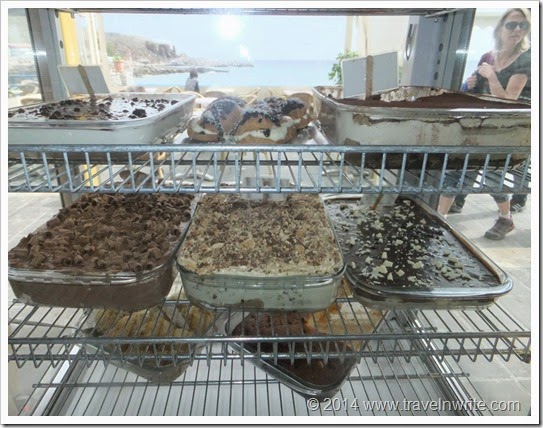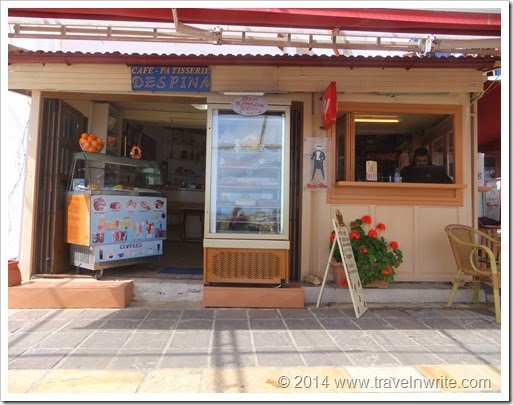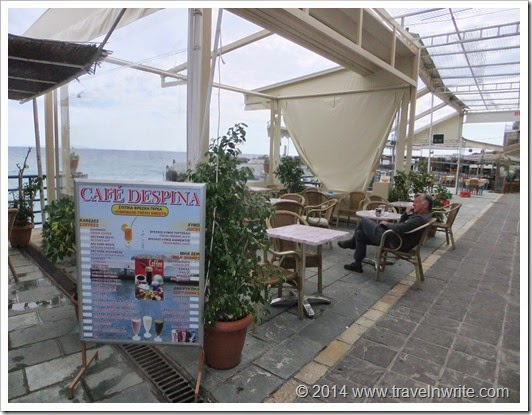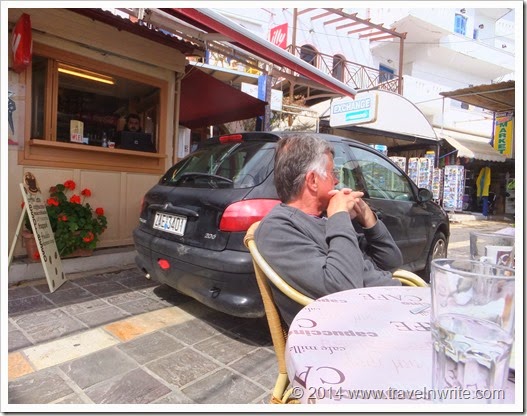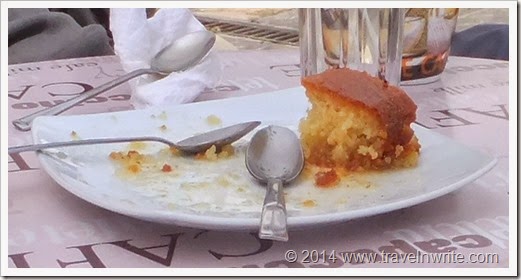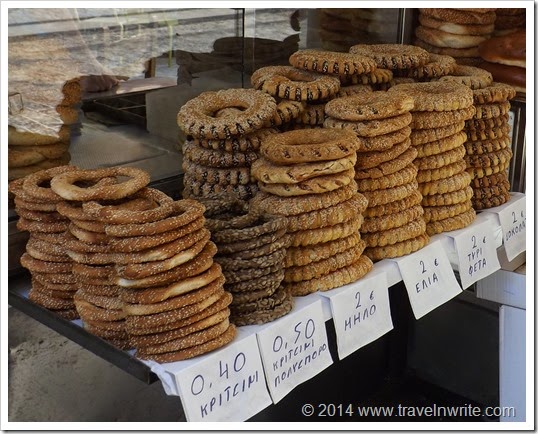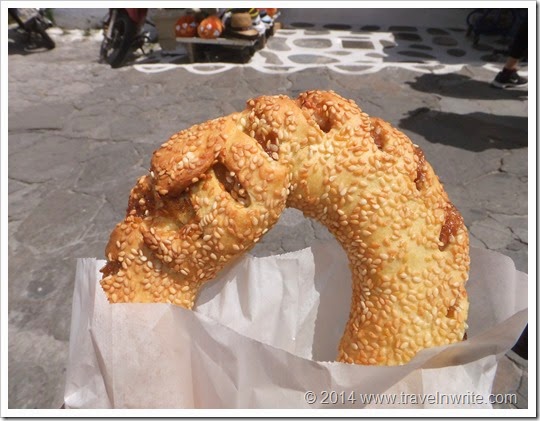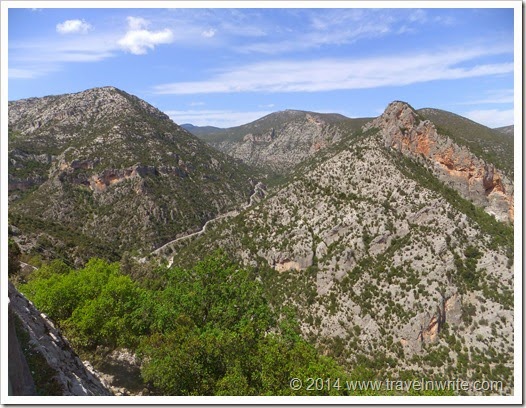Our trip back to Greece’s Mani region this summer spanned a time period that included both our wedding anniversary and my birthday. . . what better place on earth to celebrate such occasions, right?
While our days were busy with ‘chores’ related to purchasing a house there (see last week’s post) we did give ourselves our anniversary evening ‘off’ and spent it dining at a hotel restaurant that came recommended highly on TripAdvisor and had also been included in as a Top Choice in Lonely Planet’s guidebook.
This wasn’t your run-of-the-mill hotel restaurant. The setting was one of the most magical we’ve seen in Greece ~ in the midst of an olive grove at the side of the sea. It just doesn’t get any better than that!
Restaurant Elies is part of a small bungalow-style hotel complex of the same name one mile north of Kardamyli (also Kardamili) town. The setting and the décor – from the blue and white cushions in the bar’s open air lounge to the yellow and olive green colored tables and chairs -- couldn’t have been more Mediterranean. We’d want to incorporate both of these ideas when decorating that new house, we’d decided. . .
As night approached, the restaurant transformed from its daytime casual to nighttime elegance with white table cloths and candles.
And the menu offered such a foodie feast it was difficult to decide what to eat:
We finally made our selections – fried giant white beans starter, sea bass on a bed of wild greens and rigatoni with a fresh basil pesto sauce.
Wish I’d photographed dessert but by then I was in such a state of (foodie) bliss the camera was long forgotten. If you get to the area, we’d highly recommend this place as a ‘must visit’.
We’ll continue the story of our house buying trip to Greece on Thursday. . .hope to see you then!
For restaurant or hotel information: www.elieshotel.gr
Linking this post up with Mosaic Monday and Foodie Tuesday
Showing posts with label Greek food. Show all posts
Showing posts with label Greek food. Show all posts
Monday, July 28, 2014
Tuesday, June 24, 2014
Taking (Another) Bite Out of Greece
I told you that we’d eaten so many wonderful foods while in Greece that I had to tell you about them in a two-part post. Having given you the sampler plate earlier, pull up a chair and prepare for another Greek feast. . .
Coming from the United State’s Pacific Northwest where seafood is plentiful and relatively inexpensive, we’ve not eaten much fish in Greece. We’ve found it to be extremely expensive in comparison to other dishes (the waters, they say, have been somewhat ‘fished out’).
On occasion something comes along that we can’t resist, like this warm octopus salad served to us at a delightful place named, Salt and Sugar, in Poulithro, a small town on the east coast of the Peloponnese:
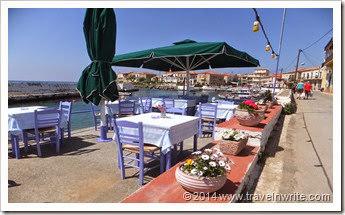 On the west coast of the Peloponnese, we sampled a variety of dishes at this delightful restaurant (pictured on the left) in the harbor town of Agios Nikolaos, (St. Nicholas) where outside tables overlook the harbor.
On the west coast of the Peloponnese, we sampled a variety of dishes at this delightful restaurant (pictured on the left) in the harbor town of Agios Nikolaos, (St. Nicholas) where outside tables overlook the harbor.
Among our favorites here were some of the more traditional Greek dishes – many of which are made in such large batches that they aren’t made until tourist season is in full-swing -- dishes like the labor-intensive pasta dish called Patitssio.
A layered dish a bit like macaroni and and a bit like lasagna, the macaroni-shaped pasta is layered with a red meat sauce and topped with Béchamel sauce. One serving is easily shared between two people.
You might be surprised at how much pasta is served in Greece and how good those dishes are ~ some sources say these Italian-like recipes have been handed down through the generations; having originated here way back while the Venetians occupied so much of this country.
We are in agreement that we each have a ‘peasant palate’ – sometimes the simpler and least expensive the ingredients, the better. Such is the case with slow-cooked flat beans. Simmered for hours in a tomato sauce flavored with fresh herbs this dish is inexpensive and filling enough to be shared by two.
We’ve lucked out on our last two visits and arrived at just about the time the first artichoke harvest of the season. One of our favorite dishes – pictured above - is artichokes, served in a lemon sauce with peas, potatoes and carrot chunks. I am happy to report that among our Greek words – good morning, good afternoon and good night – I can now say, “ah-gee-nar-rus” the word for artichoke and if I say it with the right inflection the server knows I am inquiring about the availability of this dish.
And of course we can’t sing the praises of Greek food and not mention the iconic, moussaka. This lovely layered dish of aubergines (a much lovelier name used throughout Europe than ‘eggplants’ as we call them in the U.S), potatoes and meat sauce, also topped with a thick Béchamel. This tasty bit of heaven also came with those lemon/olive oil roasted potatoes on the side.
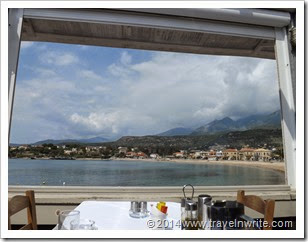 This dish and the one pictured below were eaten at a table with a picture perfect view of the crescent-shaped beach in another small town, Stoupa, in the The Mani area of the Peloponnese.
This dish and the one pictured below were eaten at a table with a picture perfect view of the crescent-shaped beach in another small town, Stoupa, in the The Mani area of the Peloponnese.
Stoupa, is just a a few minutes by car from Ag. Nikolaos. With such good eateries in both towns it is difficult to choose where to eat.
We couldn’t resist trying a traditional egg dish served scrambled with feta cheese, fresh tomatoes and ham.
One of the things we like most about Greek food and the restaurants in which they are served is the pace. The food is served slowly, it is to be eaten slowly and there is never a rush to get you up and out of the place.
You’ll not receive a bill until you ask for one and then – in the smaller cities – you’ll have some treat, a drink, or fruit, or pastry – delivered before that bill as a gesture of thanks for your business.
If You Go:
The pin on the right marks Poulithro and the left denotes Ag. Nikolaos and Stoupa.
That’s it for this week’s Foodie Tuesday. Bon appetit to you where ever you are dining this week!
What foods have you eaten in your travels that have left a lasting impression? Tell us about them in the comments below.
Linking up:
Foodie Tuesday at Inside Journeys
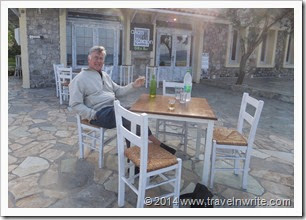 |
| Salt and Sugar - Poulithro, Greece |
On occasion something comes along that we can’t resist, like this warm octopus salad served to us at a delightful place named, Salt and Sugar, in Poulithro, a small town on the east coast of the Peloponnese:
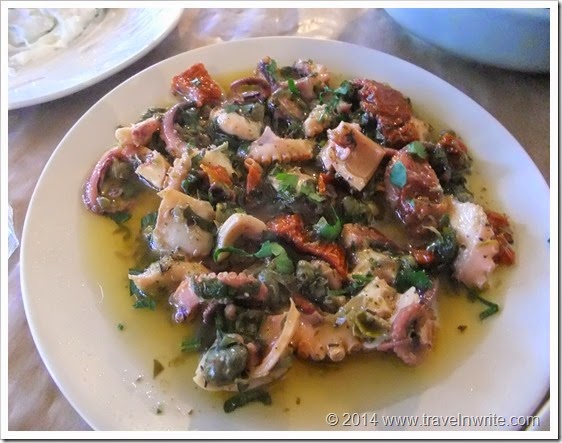 |
| Octopus Salad |
The chunks of octopus were tender and mixed with onion, capers and sundried tomatoes – and served with a wonderful olive oil and lemon sauce.
 On the west coast of the Peloponnese, we sampled a variety of dishes at this delightful restaurant (pictured on the left) in the harbor town of Agios Nikolaos, (St. Nicholas) where outside tables overlook the harbor.
On the west coast of the Peloponnese, we sampled a variety of dishes at this delightful restaurant (pictured on the left) in the harbor town of Agios Nikolaos, (St. Nicholas) where outside tables overlook the harbor.Among our favorites here were some of the more traditional Greek dishes – many of which are made in such large batches that they aren’t made until tourist season is in full-swing -- dishes like the labor-intensive pasta dish called Patitssio.
A layered dish a bit like macaroni and and a bit like lasagna, the macaroni-shaped pasta is layered with a red meat sauce and topped with Béchamel sauce. One serving is easily shared between two people.
You might be surprised at how much pasta is served in Greece and how good those dishes are ~ some sources say these Italian-like recipes have been handed down through the generations; having originated here way back while the Venetians occupied so much of this country.
We are in agreement that we each have a ‘peasant palate’ – sometimes the simpler and least expensive the ingredients, the better. Such is the case with slow-cooked flat beans. Simmered for hours in a tomato sauce flavored with fresh herbs this dish is inexpensive and filling enough to be shared by two.
We’ve lucked out on our last two visits and arrived at just about the time the first artichoke harvest of the season. One of our favorite dishes – pictured above - is artichokes, served in a lemon sauce with peas, potatoes and carrot chunks. I am happy to report that among our Greek words – good morning, good afternoon and good night – I can now say, “ah-gee-nar-rus” the word for artichoke and if I say it with the right inflection the server knows I am inquiring about the availability of this dish.
And of course we can’t sing the praises of Greek food and not mention the iconic, moussaka. This lovely layered dish of aubergines (a much lovelier name used throughout Europe than ‘eggplants’ as we call them in the U.S), potatoes and meat sauce, also topped with a thick Béchamel. This tasty bit of heaven also came with those lemon/olive oil roasted potatoes on the side.
 This dish and the one pictured below were eaten at a table with a picture perfect view of the crescent-shaped beach in another small town, Stoupa, in the The Mani area of the Peloponnese.
This dish and the one pictured below were eaten at a table with a picture perfect view of the crescent-shaped beach in another small town, Stoupa, in the The Mani area of the Peloponnese. Stoupa, is just a a few minutes by car from Ag. Nikolaos. With such good eateries in both towns it is difficult to choose where to eat.
We couldn’t resist trying a traditional egg dish served scrambled with feta cheese, fresh tomatoes and ham.
 |
| Salt and Sugar interior |
You’ll not receive a bill until you ask for one and then – in the smaller cities – you’ll have some treat, a drink, or fruit, or pastry – delivered before that bill as a gesture of thanks for your business.
If You Go:
The pin on the right marks Poulithro and the left denotes Ag. Nikolaos and Stoupa.
That’s it for this week’s Foodie Tuesday. Bon appetit to you where ever you are dining this week!
What foods have you eaten in your travels that have left a lasting impression? Tell us about them in the comments below.
Linking up:
Foodie Tuesday at Inside Journeys
Monday, June 16, 2014
Greece: “But, what do you eat there?”
There are certain people we know who don’t share our enthusiasm for travel. They list the logistics and planning or those unknown experiences . . .like eating different food as reasons for not setting forth.
I can tell you – and our bathroom scales reconfirm this – we love the foods (and drinks, of course) we discover on our travels!
Some of our favorite food is Greek. We found so many culinary delights as we traveled around Greece this spring that I am serving up a two-part report; beginning this week on our food-fest there and starting with perhaps the most recognizable dishes:
Pita Gyro: This fast food is the cheapest ‘full meal deal’ in town. Thinly sliced lamb, beef or chicken, tomatoes, onions, French fries, yogurt with paprika (pictured above) or tzatziki, a yogurt sauce comes wrapped in hot pita. The cost usually under $5 US.
Greek Salad: Unlike the versions we are served back home in the U.S. here the bowl is filled with chunks of tomatoes, cucumbers, onion, whole olives with pits and slabs of feta, seasoned with oregano and olive oil and vinegar mixtures. Usually in the $5 – $7 US range and enough to share between two.
 Hummus: While we call it a dip in the U.S. it sometimes is listed under salads here – other times as a meze, or small plate.
Hummus: While we call it a dip in the U.S. it sometimes is listed under salads here – other times as a meze, or small plate.
This traditional mixture of garlic, olive oil, garbanzo beans and tahini, is one of our favorites. In the photo to the left, the restaurant served it with sautéed onions. Less than $5 US.
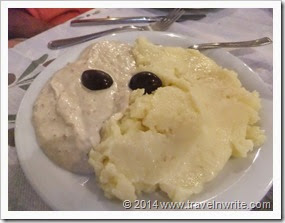 Two other sauce/salad/mezes: are the traditional – tzatziki, (left side of the plate) yogurt, cucumber, oft times a bit of grated carrot and varying amounts of garlic and garlic salad basically garlic and mashed potatoes mixed together and served cold or at room temperature.
Two other sauce/salad/mezes: are the traditional – tzatziki, (left side of the plate) yogurt, cucumber, oft times a bit of grated carrot and varying amounts of garlic and garlic salad basically garlic and mashed potatoes mixed together and served cold or at room temperature.
Greek meatballs rival that of their Italian neighbors. Here, however, they aren’t served with pasta. Instead, potatoes – slow roasted in the oven with oregano, olive oil and lemon juice – share the plate. (And thank goodness, those baskets of bread are served as a routine part of every meal. This one came in handy for dredging through that olive oil and lemon sauce!)
Stuffed grape leaves – served as mezes here, are a tart lemon-flavored treat filled with rice and served at room temperature or barely warmed. We ate many of these but I am featuring the ones served at The Nest, a restaurant (known for its traditional Greek food) tucked in the maze of the Old Town, Chora, on Ios Island.
This family-owned restaurant and the food it served, captured our hearts (and stomachs) and drew us back two of the three nights we were in town. Among the many dishes we sampled were these grape leaves. The owner said that the leaves are grown in his cousin’s garden and each morning his mother comes in to make them ~ now who could resist that?
Note: The opening photo is of pastries (some of you saw it on Facebook) - a gift for Easter from Maria, the lady who runs Pension Loutro Bay, on the southern coast of Crete, where we spent the holiday this year.
Thanks for your time today – we hope you’ll be back later this week!
Linking up:
Foodie Tuesday
 |
| Easter pastries - Greece |
Some of our favorite food is Greek. We found so many culinary delights as we traveled around Greece this spring that I am serving up a two-part report; beginning this week on our food-fest there and starting with perhaps the most recognizable dishes:
Pita Gyro: This fast food is the cheapest ‘full meal deal’ in town. Thinly sliced lamb, beef or chicken, tomatoes, onions, French fries, yogurt with paprika (pictured above) or tzatziki, a yogurt sauce comes wrapped in hot pita. The cost usually under $5 US.
Greek Salad: Unlike the versions we are served back home in the U.S. here the bowl is filled with chunks of tomatoes, cucumbers, onion, whole olives with pits and slabs of feta, seasoned with oregano and olive oil and vinegar mixtures. Usually in the $5 – $7 US range and enough to share between two.
 Hummus: While we call it a dip in the U.S. it sometimes is listed under salads here – other times as a meze, or small plate.
Hummus: While we call it a dip in the U.S. it sometimes is listed under salads here – other times as a meze, or small plate. This traditional mixture of garlic, olive oil, garbanzo beans and tahini, is one of our favorites. In the photo to the left, the restaurant served it with sautéed onions. Less than $5 US.
 Two other sauce/salad/mezes: are the traditional – tzatziki, (left side of the plate) yogurt, cucumber, oft times a bit of grated carrot and varying amounts of garlic and garlic salad basically garlic and mashed potatoes mixed together and served cold or at room temperature.
Two other sauce/salad/mezes: are the traditional – tzatziki, (left side of the plate) yogurt, cucumber, oft times a bit of grated carrot and varying amounts of garlic and garlic salad basically garlic and mashed potatoes mixed together and served cold or at room temperature.Greek meatballs rival that of their Italian neighbors. Here, however, they aren’t served with pasta. Instead, potatoes – slow roasted in the oven with oregano, olive oil and lemon juice – share the plate. (And thank goodness, those baskets of bread are served as a routine part of every meal. This one came in handy for dredging through that olive oil and lemon sauce!)
Stuffed grape leaves – served as mezes here, are a tart lemon-flavored treat filled with rice and served at room temperature or barely warmed. We ate many of these but I am featuring the ones served at The Nest, a restaurant (known for its traditional Greek food) tucked in the maze of the Old Town, Chora, on Ios Island.
This family-owned restaurant and the food it served, captured our hearts (and stomachs) and drew us back two of the three nights we were in town. Among the many dishes we sampled were these grape leaves. The owner said that the leaves are grown in his cousin’s garden and each morning his mother comes in to make them ~ now who could resist that?
Note: The opening photo is of pastries (some of you saw it on Facebook) - a gift for Easter from Maria, the lady who runs Pension Loutro Bay, on the southern coast of Crete, where we spent the holiday this year.
Thanks for your time today – we hope you’ll be back later this week!
Linking up:
Foodie Tuesday
Tuesday, May 27, 2014
Hora Sfakia: An Afternoon at Despina’s
Some of the best travel memories are those made from life’s simplest pleasures ~ like that afternoon at Despina’s on the waterfront in Hora Sfakia, Crete.
Hora Sfakia, as I’ve told you in earlier posts, was a hub of activity in World War II, (click here for that post). These days this small quiet village on Crete’s southern shore is a stopping off place for hikers heading to or from the three nearby gorges: Samaria, Imbrios or Aradena. There are some people like us, who don’t hike, but simply adore the town and think a trip to Crete is incomplete without a visit here.
Because April's visit was our fourth here, we were looking forward to seeing folks we’ve gotten to know – or at least recognize – from our earlier visits. Most of the shop keepers and restaurateurs call out greetings both to new-comers and ‘regulars’ like ourselves from their entryways in this pedestrian-friendly area of town.
One of the most welcoming is Despina the owner and operator of a small café and patisserie along the waterfront here. . . she’s also the creator of those wonderful goodies in the display cases pictured above and below.
Despina’s has been open year-round here for 15 years.. In the high season (summer) she opens at 8 a.m. and closes at 11 p.m. then she goes to work making the new creations that will fill her shelves the following morning. (She admitted that often times she gets but a couple hours sleep each night during the height of the tourist season.)
The temptations that fill the refrigerated shelves usually include the likes of her cheese cakes and apple pie, chocolate souffle, tiramisu cheesecake, mocha amaretto and traditional Kataifi, a pastry that looks like shredded wheat, stuffed with nuts and drenched in honey. During our recent visit, however, it was a lemon cake in an incredible lemon sauce – both made from fresh lemons that kept calling out each time we passed.
In past visits our will power has steered us past her cafe, with just a tingle of the sweet tooth. Sometimes we’ve had coffee there or a raki the local 'fire water' or two to end our evening’s pleasures. We’ve managed to resist the Sweet Siren.
Like many of the restaurants that line the waterfront in this small town, the kitchen and inside seating is separated from the ‘deck’ seating by a walkway/driveway. While not many cars pass by, when they do, they are close – but that just adds to the ambiance of the experience.
But this time that lemon cake was too much to resist. I’d like to have shown you how big a piece it was that we shared, but I barely remembered to pull out the camera before we had wolfed it away completely. . .
That is our Foodie Tuesday tale this week for our linkup at Inside Journeys. Hope you’ll join us Thursday when we “Target Tinos”. (Yep, you have to come back to figure that one out.) Thanks for the time you spent with us today~as always, it is appreciated.
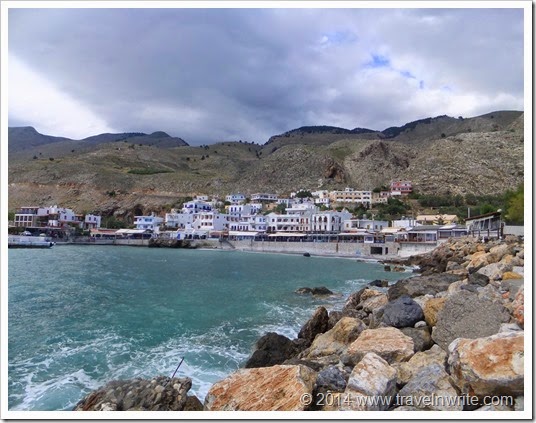 |
| Hora Sfakia - Crete |
Because April's visit was our fourth here, we were looking forward to seeing folks we’ve gotten to know – or at least recognize – from our earlier visits. Most of the shop keepers and restaurateurs call out greetings both to new-comers and ‘regulars’ like ourselves from their entryways in this pedestrian-friendly area of town.
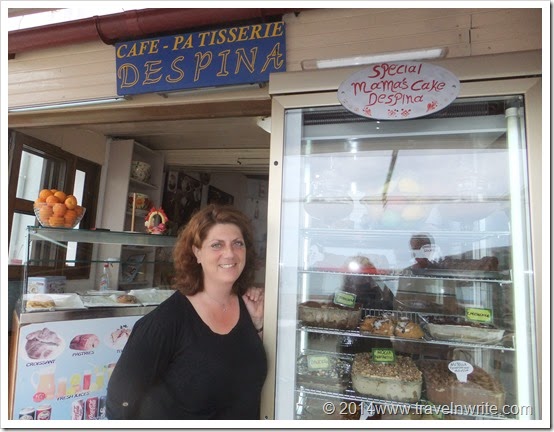 |
| Despina |
Despina’s has been open year-round here for 15 years.. In the high season (summer) she opens at 8 a.m. and closes at 11 p.m. then she goes to work making the new creations that will fill her shelves the following morning. (She admitted that often times she gets but a couple hours sleep each night during the height of the tourist season.)
The temptations that fill the refrigerated shelves usually include the likes of her cheese cakes and apple pie, chocolate souffle, tiramisu cheesecake, mocha amaretto and traditional Kataifi, a pastry that looks like shredded wheat, stuffed with nuts and drenched in honey. During our recent visit, however, it was a lemon cake in an incredible lemon sauce – both made from fresh lemons that kept calling out each time we passed.
In past visits our will power has steered us past her cafe, with just a tingle of the sweet tooth. Sometimes we’ve had coffee there or a raki the local 'fire water' or two to end our evening’s pleasures. We’ve managed to resist the Sweet Siren.
Like many of the restaurants that line the waterfront in this small town, the kitchen and inside seating is separated from the ‘deck’ seating by a walkway/driveway. While not many cars pass by, when they do, they are close – but that just adds to the ambiance of the experience.
But this time that lemon cake was too much to resist. I’d like to have shown you how big a piece it was that we shared, but I barely remembered to pull out the camera before we had wolfed it away completely. . .
That is our Foodie Tuesday tale this week for our linkup at Inside Journeys. Hope you’ll join us Thursday when we “Target Tinos”. (Yep, you have to come back to figure that one out.) Thanks for the time you spent with us today~as always, it is appreciated.
Tuesday, May 20, 2014
Turkish Simit or Greek Koulouri: By Whatever Name. . .
. . .the fact is, it is yummy!

One of my favorite foods when eating in Greece is the ‘koulouri’ or in Turkey, the ‘simit’. It is basically the same food, just known by different names.
Similar versions of this bread-shaped-like-a-huge-donut can be found throughout the Middle East, including Serbia, Egypt, Lebanon and the Balkans. In each place, it is called by a different name. The creations originated centuries ago.
By whatever name, it is one of the cheapest foods to be found in both countries in which we traveled this spring. Depending on your point of view, simit or koulouri is either ‘street food’ or ‘fast food’ (and one of the healthiest fat-and sugar-free fast foods to be eaten.)
We were introduced to the Turkish simit a few years back while exploring the port city of Trabzon, Turkey, (where the photo above was taken). I was so impressed with my new food find, that I wrote about it and had to show off the one I was eating – still warm out of the bakery oven. (Click here for that post).
At a cost of about one Euro or a Turkish Lira (about $1.25US) these baked dough circles encrusted with sesame seeds are so filling that it is easy to eat one for lunch or breakfast. (They are probably great with a bit of jam on them.) We’ve always eaten them on-the-go; purchased from street vendors in both Greece and Turkey who set up carts like the one pictured below. This enterprising salesman on Ermou Street in Athens had added donuts to his offerings, but they weren’t selling as fast as those sesame wonders.

This fellow also served variety of koulouri, which was new to us. It was filled with chocolate – not an overly sweet chocolate and with a consistency of cake frosting. Those lovelies are stacked on the center right in the photo below. (We split one of them for ‘lunch’ and ate on it all afternoon – as a little went a long way.)
While researching the history of simit and koulouri, I came across a two-year-old web article that said the Istanbul Simit Tradesman Chamber had petitioned for an international patent for the circular creation to be officially known at the Turkish Simit. I found no follow up reports, so that will remain a mystery unless one of you kind readers can update us on that initiative.
By whatever name. . .my favorite new flavor came from a small bakery in Mykonos, Greece. It was there I discovered the wonders of the apple-filled koulouri. It was heavenly! Again,purchased for ‘lunch’ but it lasted all afternoon. BTW, if I had to choose between this and apple pie, this tasty morsel would win, hands down!
We came to expect those simit/koulouri vendors and their carts at ferry ports and tourist attractions and along city streets. The most enterprising salesman though was the man who passed us on the Galata Bridge as we walked over Istanbul’s Golden Horn. He was selling to the fishermen who lined the bridge:
Have you tried these tasty treats or something similar? Where did you eat them and by what were they called?
We are linking up this week with Inside Journeys Foodie Tuesday and Noel Morata’s Travel Photo Monday. Hope you’ll come back again later this week for another serving of our Greek and Turkish travels. As always, thanks for your time and your comments!
Tuesday, March 25, 2014
Greece: A honey of a destination
Greece, quite literally, is a honey of a destination.
As we prepare to return this spring to the Peloponnese, Crete and other yet-to-be-determined places we know the one common treasure we’ll find is their liquid gold. . . honey.
In Greece, honey is infused into soap and shampoo. You can find it in beauty products from face cream to foot lotions. We’ve even used wax balms on our lips – thanks to those industrious bees who produce the honey.
We’ve drizzled it by thick spoonful onto fresh-made Greek yogurt for breakfast. We finished our evening meals with complimentary servings of fresh fruit slices topped with it or pieces of cake soaked with it.
While honey is commonly found in every region of Greece, each region’s product has a slightly different taste and characteristics.
Busy as Bees. . .
As we drove narrow roadways that curled and climbed through the rugged terrain of both the Peloponnese and Crete -- each is a honey producing area -- it became a contest of sorts to spots hives we passed along the way.
By the numbers there are some 1.3 million hives and 25,000 beekeepers responsible for the 12,000 tons of honey produced annually in Greece.
Luckily we will be returning to Greece, during the ‘honey season’ which generally begins in March and continues to the end of November in the southernmost areas of the country.
During this time hives are moved from field to field and slope to slope. The moves provide the seasonal flavors to the honey – orange blossoms in May, wild thyme in July, forests in September and Heather fields in both May and September. Honey is harvested after the feeding periods to capture the best flavors.
We will be making our fifth trip to Crete – we can’t resist its charms.
Or is it the the thick, hearty thyme honey we’ve discovered in southern Crete that keeps us returning?
It’s a flavor unlike any honey we’ve had anywhere else. We’ve commonly referred to it as our ‘nectar of the Gods’.
Honey of the Gods. . .
However, it was in Poulithro, a coastal village in the Peloponnese – at the Hotel Byzantinon, where we were, last year, introduced to a honey blend so rich in flavor and beautifully colored (an almost pearl metallic highlight) that we understood completely why it is called, “Melithion” which means, ‘honey of the Gods’.
Christos Kritsidimas, son of the hotel owners, said his family had been buying the honey and serving it as part of the breakfast they provide with a room rental. “The guests kept asking where they could buy the honey. They wanted to take it home.”
Talks began with the honey suppliers and Christos, who formerly worked in the banking industry, began Vasiliki, his new company that produces and markets, “Melithion” and soon other varieties of honey.
“Vasiliki,” he explained has a double meaning. It is both his mother’s name and synonymous with royalty. “We think of this product as the Rolls Royce of honey.”
Melithion is a blend of primarily black fir tree honey dew and Thyme nectar, with combinations of smaller amounts of herbs and local flowers contributing to its unique blend, including Arbutus, Maple, Heather and Tea.
The Black Fir grows at the 1,500 meter (4,921 feet) elevation in the Mainalo mountain range that towers over the Peloponnese southwest of Tripoli. It’s a distinct species in the fir family and produces a honey known as Banilias (vanilla) – it is the only Greek honey to carry a Protected Designation of Origin. This honey is considered an excellent source of essential trace elements include potassium, magnesium, phosphorus and iron – as well as numerous vitamins.
“Our particular variety of honey provides a perfect balance in taste with the vanilla being less sweet and the thyme being sweeter,” he explains. “It is delicately smooth in flavor with a butterscotch taste at the end.”
The black fir tree honey dew is a resin produced by microorganisms in the tree trunk. Its production is easily affected by the high elevation’s cold and wet temperatures and the harvest is difficult and costly. For that reason, the production of Melithion honey was limited last year to 12,000 jars.
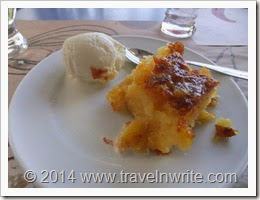 Since Vasiliki’s inception four years ago, the marketing and distribution of honey has been the company’s focus. Christos has taken the brand to trade fairs throughout Europe and hopes to grow its presence in the United States as well.
Since Vasiliki’s inception four years ago, the marketing and distribution of honey has been the company’s focus. Christos has taken the brand to trade fairs throughout Europe and hopes to grow its presence in the United States as well.
Melithion can be purchased on-line at www.elenianna.com, a premium Mediterranian gastronomy shopping experience. For us, it’s another ‘honey’ of a reason to return to Greece this spring!
Linking up:
Foodie Tuesday at Inside Journeys
 |
| Athens, Greece from our airplane 2013 |
As we prepare to return this spring to the Peloponnese, Crete and other yet-to-be-determined places we know the one common treasure we’ll find is their liquid gold. . . honey.
In Greece, honey is infused into soap and shampoo. You can find it in beauty products from face cream to foot lotions. We’ve even used wax balms on our lips – thanks to those industrious bees who produce the honey.
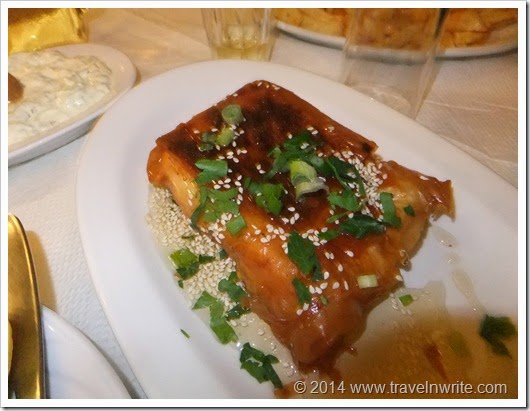 |
| Feta cheese bake in phyllo then smothered in honey, sesame seeds and onion |
We’ve drizzled it by thick spoonful onto fresh-made Greek yogurt for breakfast. We finished our evening meals with complimentary servings of fresh fruit slices topped with it or pieces of cake soaked with it.
While honey is commonly found in every region of Greece, each region’s product has a slightly different taste and characteristics.
Busy as Bees. . .
As we drove narrow roadways that curled and climbed through the rugged terrain of both the Peloponnese and Crete -- each is a honey producing area -- it became a contest of sorts to spots hives we passed along the way.
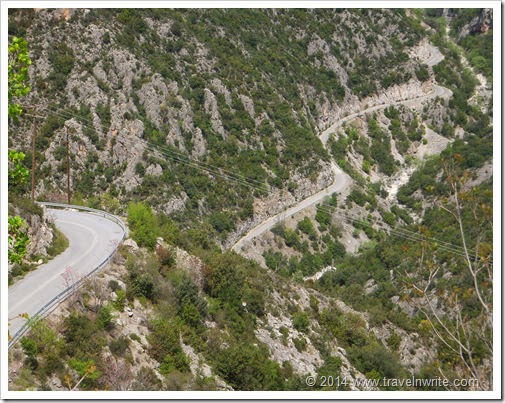 |
| Roadways aren't for the faint-hearted |
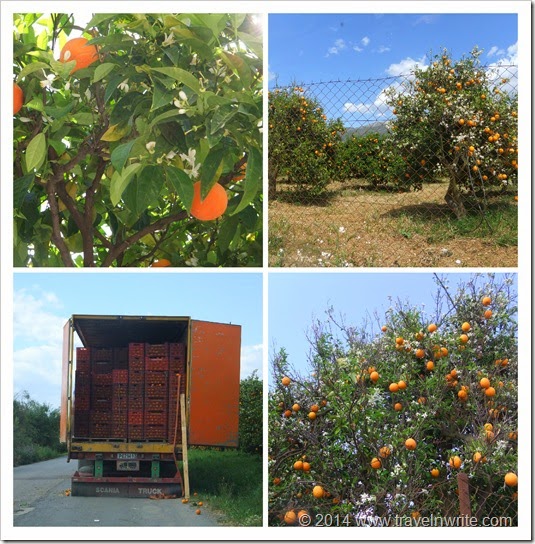 |
| Orange groves/harvest in the Peloponnese |
Luckily we will be returning to Greece, during the ‘honey season’ which generally begins in March and continues to the end of November in the southernmost areas of the country.
During this time hives are moved from field to field and slope to slope. The moves provide the seasonal flavors to the honey – orange blossoms in May, wild thyme in July, forests in September and Heather fields in both May and September. Honey is harvested after the feeding periods to capture the best flavors.
 |
| Wild thyme lines a Crete hiking path |
Or is it the the thick, hearty thyme honey we’ve discovered in southern Crete that keeps us returning?
It’s a flavor unlike any honey we’ve had anywhere else. We’ve commonly referred to it as our ‘nectar of the Gods’.
Honey of the Gods. . .
However, it was in Poulithro, a coastal village in the Peloponnese – at the Hotel Byzantinon, where we were, last year, introduced to a honey blend so rich in flavor and beautifully colored (an almost pearl metallic highlight) that we understood completely why it is called, “Melithion” which means, ‘honey of the Gods’.
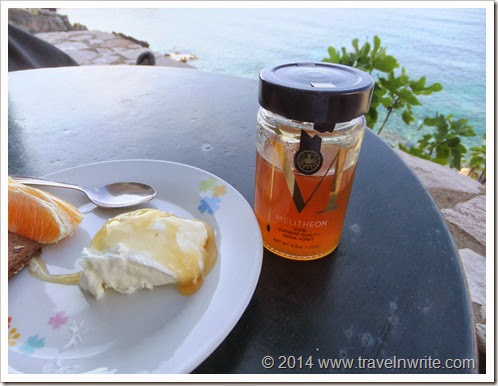 |
| Melitheon - Honey of the Gods |
Christos Kritsidimas, son of the hotel owners, said his family had been buying the honey and serving it as part of the breakfast they provide with a room rental. “The guests kept asking where they could buy the honey. They wanted to take it home.”
 |
| Christos and George Kritsidimas |
“Vasiliki,” he explained has a double meaning. It is both his mother’s name and synonymous with royalty. “We think of this product as the Rolls Royce of honey.”
Melithion is a blend of primarily black fir tree honey dew and Thyme nectar, with combinations of smaller amounts of herbs and local flowers contributing to its unique blend, including Arbutus, Maple, Heather and Tea.
The Black Fir grows at the 1,500 meter (4,921 feet) elevation in the Mainalo mountain range that towers over the Peloponnese southwest of Tripoli. It’s a distinct species in the fir family and produces a honey known as Banilias (vanilla) – it is the only Greek honey to carry a Protected Designation of Origin. This honey is considered an excellent source of essential trace elements include potassium, magnesium, phosphorus and iron – as well as numerous vitamins.
“Our particular variety of honey provides a perfect balance in taste with the vanilla being less sweet and the thyme being sweeter,” he explains. “It is delicately smooth in flavor with a butterscotch taste at the end.”
The black fir tree honey dew is a resin produced by microorganisms in the tree trunk. Its production is easily affected by the high elevation’s cold and wet temperatures and the harvest is difficult and costly. For that reason, the production of Melithion honey was limited last year to 12,000 jars.
 Since Vasiliki’s inception four years ago, the marketing and distribution of honey has been the company’s focus. Christos has taken the brand to trade fairs throughout Europe and hopes to grow its presence in the United States as well.
Since Vasiliki’s inception four years ago, the marketing and distribution of honey has been the company’s focus. Christos has taken the brand to trade fairs throughout Europe and hopes to grow its presence in the United States as well.Melithion can be purchased on-line at www.elenianna.com, a premium Mediterranian gastronomy shopping experience. For us, it’s another ‘honey’ of a reason to return to Greece this spring!
Linking up:
Foodie Tuesday at Inside Journeys
Tuesday, March 18, 2014
Another Serving of Greece. . .
Our appetite for Greece seems insatiable. . .and that’s why we will be returning this spring for another serving of this amazing country.
In preparation for the upcoming sojourn we spent some time in recent days looking at photos of last year’s visit. I need to confess,our mouths watered at the reminders of the tastes and flavors we had experienced and soon will be again enjoying. . .
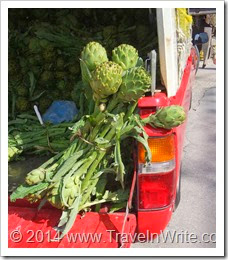 We watched pickup loads of artichokes -- looking like bouquets -- being delivered fresh from nearby gardens while in the small town of Galetas, on the Greek mainland (Peloponnese) across the channel from the island of Poros last spring.
We watched pickup loads of artichokes -- looking like bouquets -- being delivered fresh from nearby gardens while in the small town of Galetas, on the Greek mainland (Peloponnese) across the channel from the island of Poros last spring.
“Locally sourced” may be the rage among restaurateurs in the U.S. but it is a long time practice in Greece.
Our favorite meal included a plate of fresh artichoke hearts and potatoes served in a lemon and butter sauce. Each version differed slightly as these photos illustrate.
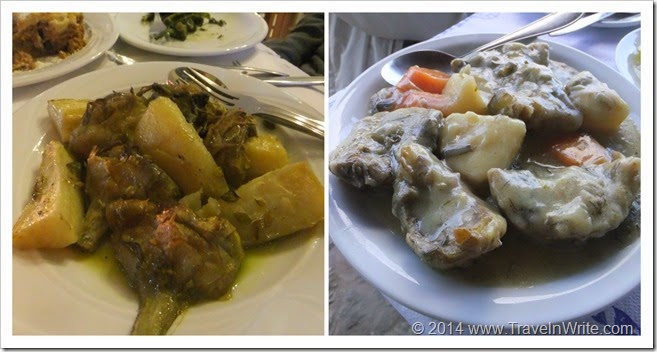
And what would a Greek feast be without a few servings of Moussaka, that multi-layered marvel made with aubergines (eggplant) and topped with a melt-in-your-mouth béchamel topping?
Only problem is that this deep-dish delight is made in huge pans. Because of the quatity, it is sometimes difficult to find in the springtime, shoulder season for tourism – when we find ourselves in Greece. Restaurants don’t make it unless there are enough diners to use it all. So, when we did find it, it was a real treat! (Servings are also huge, so one is easily shared, as we did with the one in the photo below.)
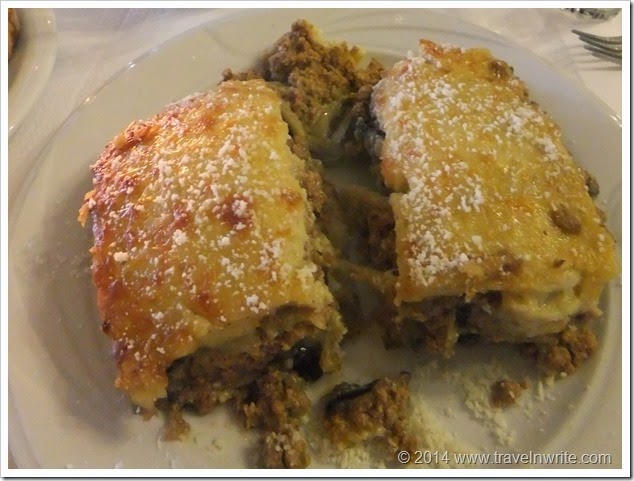
One of our favorite springtime veggies is Horta, the wild greens harvested from the rugged Greek hillsides. Admittedly it looks like a plate of spinach, but to our minds there’s nothing like Horta:
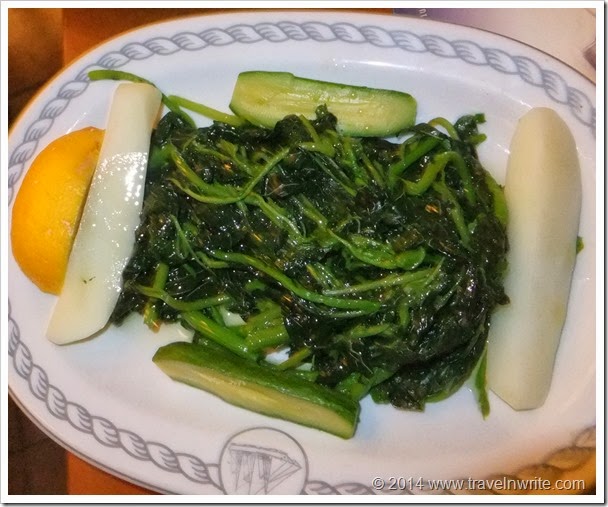
And while on a semi-healthy train of thought, there’s the fabulous Greek salad with wedges of tomatoes, onions, cucumbers and Kalamata olives topped with small slabs of Feta cheese, finished with a drizzle of olive oil and sprinkling of fresh oregano.

A new favorite we discovered on our last trip to Greece was Orange Cake – think sponge cake flavored with fresh orange juice and, of course, served with just a dab of ice cream . . .and it came as the complimentary finish to our meal at a small taverna – a place we plan to visit again this year. (Can you guess why?)
: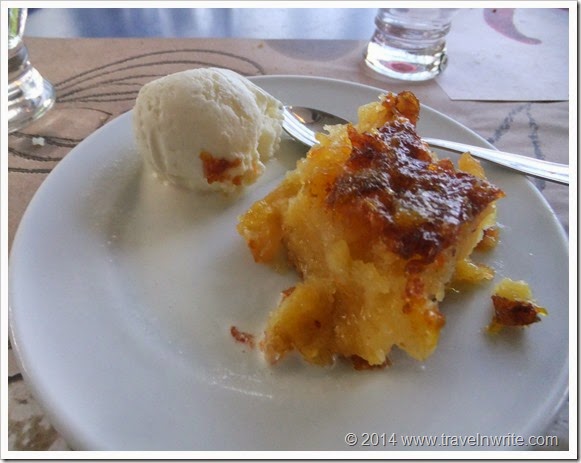
The prices were ridiculously reasonable. An example taken from my travel journal while in Kardimili, a town in The Mani region of Greece's Peloponnese:
"Dinner consisted of the large serving of bread (routinely brought with the flatware and napkins), olive oil to drizzle on it. Wild horta, a moussaka that we split, and a half liter of wine: 13.70E (about $16US last year). Maria and Harold hugged us and kissed us goodnight as we left."
While the food is amazing, it is often the settings – the tavernas, the restaurants, the family-owned places – contribute so much to the dining experience that it is difficult to leave even after a meal that we might have stretched into hours of enjoyment. Add to that a hug or kiss of thanks from the owner, or an invite back into the kitchen. . .well, for us it's the kind of place we want to linger longer. . .perhaps for the remainder of a lifetime. . .or at least return to as often as possible!
We have a ‘honey’ of a Greek story to tell you next week on Foodie Tuesday and we are taking you on a behind-the-scenes tour of cruising later this week. Hope you’ll join us again then! As always, thanks for the time you spent with us today. Safe travels~
Linking up today with Inside Journey's Foodie Tuesday.
In preparation for the upcoming sojourn we spent some time in recent days looking at photos of last year’s visit. I need to confess,our mouths watered at the reminders of the tastes and flavors we had experienced and soon will be again enjoying. . .
 We watched pickup loads of artichokes -- looking like bouquets -- being delivered fresh from nearby gardens while in the small town of Galetas, on the Greek mainland (Peloponnese) across the channel from the island of Poros last spring.
We watched pickup loads of artichokes -- looking like bouquets -- being delivered fresh from nearby gardens while in the small town of Galetas, on the Greek mainland (Peloponnese) across the channel from the island of Poros last spring. “Locally sourced” may be the rage among restaurateurs in the U.S. but it is a long time practice in Greece.
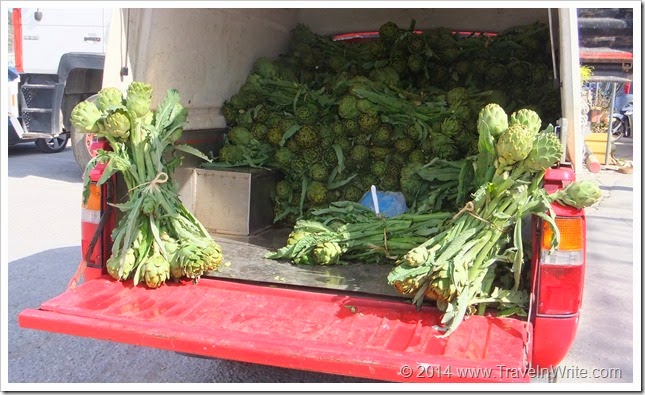 |
| Artichokes being delivered in the Peloponesse |
Our favorite meal included a plate of fresh artichoke hearts and potatoes served in a lemon and butter sauce. Each version differed slightly as these photos illustrate.

And what would a Greek feast be without a few servings of Moussaka, that multi-layered marvel made with aubergines (eggplant) and topped with a melt-in-your-mouth béchamel topping?
Only problem is that this deep-dish delight is made in huge pans. Because of the quatity, it is sometimes difficult to find in the springtime, shoulder season for tourism – when we find ourselves in Greece. Restaurants don’t make it unless there are enough diners to use it all. So, when we did find it, it was a real treat! (Servings are also huge, so one is easily shared, as we did with the one in the photo below.)

One of our favorite springtime veggies is Horta, the wild greens harvested from the rugged Greek hillsides. Admittedly it looks like a plate of spinach, but to our minds there’s nothing like Horta:

And while on a semi-healthy train of thought, there’s the fabulous Greek salad with wedges of tomatoes, onions, cucumbers and Kalamata olives topped with small slabs of Feta cheese, finished with a drizzle of olive oil and sprinkling of fresh oregano.

A new favorite we discovered on our last trip to Greece was Orange Cake – think sponge cake flavored with fresh orange juice and, of course, served with just a dab of ice cream . . .and it came as the complimentary finish to our meal at a small taverna – a place we plan to visit again this year. (Can you guess why?)
:

The prices were ridiculously reasonable. An example taken from my travel journal while in Kardimili, a town in The Mani region of Greece's Peloponnese:
"Dinner consisted of the large serving of bread (routinely brought with the flatware and napkins), olive oil to drizzle on it. Wild horta, a moussaka that we split, and a half liter of wine: 13.70E (about $16US last year). Maria and Harold hugged us and kissed us goodnight as we left."
While the food is amazing, it is often the settings – the tavernas, the restaurants, the family-owned places – contribute so much to the dining experience that it is difficult to leave even after a meal that we might have stretched into hours of enjoyment. Add to that a hug or kiss of thanks from the owner, or an invite back into the kitchen. . .well, for us it's the kind of place we want to linger longer. . .perhaps for the remainder of a lifetime. . .or at least return to as often as possible!
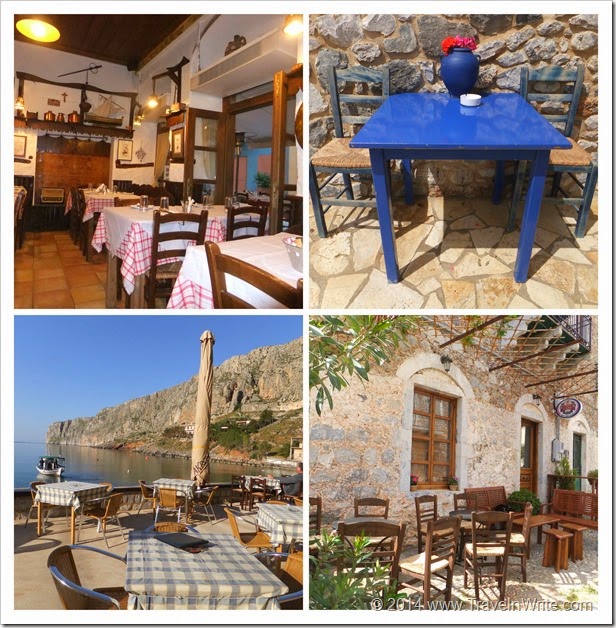 |
| From upper right: Napflion, Polithro, Kardamili, Gerolimenas - all Peloponnese locations |
Linking up today with Inside Journey's Foodie Tuesday.
Subscribe to:
Posts (Atom)
